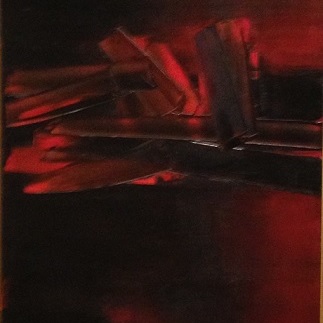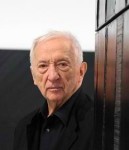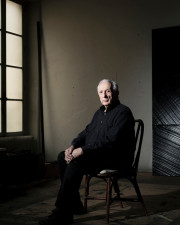Ricki Morse – The Enduring Energy of Pierre Soulages

Pierre Soulages
French, 1919-
10 Mai 1961, 1961
oil on canvas
63 3/4 × 51 1/4 in.
SBMA, Gift of Robert B. and Mercedes H. Eichholz
2014.17.25

Pierre Soulages with one of his paintings at the Pompidou Centre in Paris, Photo: AP
"The more limited the means are, the stronger the expression will be." - Pierre Soulages

Pierre Soulages in his studio at age 94.
COMMENTS
Pierre Soulages: Master of Black, Still Going Strong
By STEPHEN HEYMAN, MAY 20, 2014
PARIS — Pierre Soulages, 94, still paints every day on the floor of his atelier in the Latin Quarter here, raking heavy black pigment across large canvases in search of a particular onyx gleam that he has termed “outrenoir,” or beyond black. This color is his abstract art signature, similar to what blue was for Yves Klein or white for Robert Ryman.
“Black has been fundamental for me since childhood,” said Mr. Soulages, who, in an interview at his studio, shared a story from when he was a boy of 6 and his older sister found him drawing thick black lines in ink with a brush.
“What are you making, my little Pierre?” she asked. His reply: Snow.
Today Mr. Soulages is, at least in financial terms, the most successful living artist in France. His average auction price has increased by more than 500 percent since 2003, and the paintings he made in the 1950s and ’60s routinely fetch between $1 million and $4 million, according to artprice.com. His 2009 retrospective at the Pompidou Center, which attracted over 500,000 visitors, was the largest show the museum has ever devoted to a living artist.
Mr. Soulages’s work can be found in museums around the world, including the Solomon R. Guggenheim Museum in New York and the Tate Gallery in London. In 2001, he became the first contemporary artist to be exhibited at the Hermitage, in St. Petersburg. “When the curator told me I was the only living artist in the collection, I said, ‘Thank you, I will try to stay that way,”’ Mr. Soulages said.
In December, Mr. Soulages will be 95, but he says he is not considering retirement, much less his legacy. “I only think about what I am going to do tomorrow,” he said in French. “And tomorrow, I want to paint.”
In the United States, where he is relatively little-known, his first exhibition in 10 years is now on view in a double show at the galleries of Dominique Lévy and Emmanuel Perrotin, which occupy the same building at 909 Madison Avenue, at 73rd Street.
Later this month, in his birthplace of Rodez, in the south of France, the Musée Soulages will open with a collection of 500 works donated by the artist, which are valued at 40 million euros, or $54.7 million. The museum, housed in a series of rusty black steel cubes, was designed by the Catalan architects RCR and contains a cafe by the Michelin three-star chef Michel Bras. Mr. Soulages insisted that Mr. Bras design a menu that art students could afford, and he also set aside a 5,000-square-foot space in the museum to exhibit work by a diverse range of artists.
A former rugby player, Mr. Soulages stands well over 6 feet tall and dresses only in black. His body language is often described in the same terms as his paintings: strong, vital, powerful. “I’ve decided to lose count of his age,” Ms. Lévy said. “I always feel he’s challenging me and pushing me and such a force of nature.”
The New York show, on view through June, brings together postwar paintings on loan from museums and collectors and 14 “outrenoir” paintings made between 2012 and 2013. It coincides with a book, “Soulages in America,” published by Ms. Lévy and distributed by D.A.P., that explores Mr. Soulages’s rich, but mostly forgotten, legacy in the United States.
In the 1950s and 1960s, when he was represented by the legendary New York dealer Samuel M. Kootz, Mr. Soulages’s work was seen as a kind of French analog to the Abstract Expressionism of New York School artists like Mark Rothko, Willem de Kooning, Milton Resnick and Robert Motherwell. Mr. Soulages knew and remembers most of them fondly, especially Rothko, whom he once threw a party for at his studio in Paris.
Long before Mr. Soulages made a name for himself in France, American museums were purchasing his paintings, beginning with the Phillips Collection, in 1951, and then the Museum of Modern Art, in 1952. During the 1950s and ’60s, when he was connected to the American modern art world via Mr. Kootz, half of Mr. Soulages’s works were purchased by institutions or collectors in the United States, including Nelson A. Rockefeller and a number of filmmakers like Alfred Hitchcock, Billy Wilder and Otto Preminger.
But when Mr. Kootz’s gallery closed, in 1966, Mr. Soulages abruptly exited the American art scene.
“Fashions were changing just around that time with the rise of Pop and Op and Minimalism,” said Harry Cooper, the curator and head of modern art at the National Gallery in Washington, D.C., who worked on Mr. Soulages’s catalogue raisonné when he was a graduate student at Harvard, in the 1990s. “I think that probably made it a lot harder, at least for an artist who was roughly in the Abstract Expressionist vein who was not an American.”
Mr. Cooper has hung paintings by Mr. Soulages next to works by Dubuffet and Giacometti at the National Gallery, and said he believed Mr. Soulages’s oeuvre merits a fresh look from American curators.
“The old comparison to Franz Kline is misplaced. His work is very different, much more elegant, in some ways less gritty and muscular,” he said. “The paintings are in museum storage all over the country. It’s just a matter of curators going down there.”
As a teenager, Mr. Soulages was fascinated by prehistoric art, particularly the 3,000-year-old monoliths scattered near his home in the Aveyron region. (Their low-relief carvings have echoes in many of his outrenoir paintings.) Later he discovered reproductions of the cave paintings at places like Lascaux, Altamira or Chauvet, where some charcoal animal paintings were made 30,000 years ago. “These caves were total darkness. People painted in the dark, they painted with the dark,” Mr. Soulages said. (In French, noir can be used to mean both “dark” and “black.”)
Mr. Soulages has kept close to his provincial roots. He and his wife of more than 70 years, Colette, divide their time between Paris and a house overlooking the Mediterranean, in Sète, near Montpellier. In a corner of the garden he rolls up canvases that don’t excite him and burns them. “I paint by crisis,” Mr. Soulages said. “Sometimes it works, sometimes it doesn’t. If we know exactly what we are going to do before we do it we are not artists but artisans.”
Mr. Soulages dates the discovery of “outrenoir” to 1979. Before, black was a constant presence in his paintings as an “element of contrast” with other colors. The compositions, sometimes made with walnut stain, often featured thick, calligraphic strokes against lighter backgrounds. Then, one day, he was furiously working on a painting, and “everything became black.”
“I thought it was bad. But I continued working on it for two or three hours because, I felt that it would become somehow stronger if I kept working on it. Eventually I went to sleep, and a few hours later I looked at what I had done,” he said. “I was no longer working in black but working with the light reflected by the surface of the black. The light was dynamized by the strokes of paint. It was another world.”
Brooks Adams, an art critic and contributing editor at Art in America who has written about Mr. Soulages, said the paintings he was now making in his 90s are remarkable because they don’t smack of a late style. “It doesn’t have some new sweetness, some faintly gaga quality, some memory of childhood coming in,” Mr. Adams said. “They’re still very hip.”
Mr. Soulages said he sometimes struggled to account for his popularity. “It stupefies me — some people have cried when they see my paintings,” he said. He can only explain it by saying the color taps into something basic, human and timeless. “Black is the color of the origin of painting — and our own origin. In French, we say the baby ‘sees the day,’ to mean he was born. Before that, of course, we were in the dark.”
- A version of this article appears in print on May 21, 2014, in The International New York Times.
---------------------------------
[Review of the Soulages Retrospective at the Pompidou Centre, Paris, 2009]
Oils, inks and acrylics of all sizes go on show at the Pompidou Centre as France celebrates Pierre Soulages, a painter obsessed with the power of black.
Turning 90 next December and hailed as one of the key international figures of post-war abstraction, 100 works spanning his career are on show at Paris's Pompidou Centre until next March.
"It is touching to see 63 years of my work brought together," said Soulages, a big slow-moving man dressed, appropriately and as per usual, in black at a pre-launch tour of the canvases.
"But I don't much like the word 'retrospective'," he added. "I am still painting, I have works drying in the studio."
Soulages, who works in southern France in a studio looking out over the sparkling Mediterranean, is famously known for switching direction halfway through his career to emphasize how light is reflected from the color black - a concept he calls "ultra black", or "outrenoir."
Using thick layers of black paint, he scrapes and digs and etches using bits of rubber, spoons or tiny rakes to create smooth and rough textures that absorb or reject light, subtly changing monotonous black.
"I was always interested in black, even as a child," he said. "I used black paint and when someone asked what I was painting I said 'snow'. I think with hindsight that I used black to make the paper look more white."
"At home I have an "outrenoir" canvas facing the sea that changes color according to the weather," he added. "I have even seen it turn blue."
"Ultra-black is like another country," Soulages said.
Black had been an obsession with artists since the dawn of humanity, he said. "Why did people in prehistoric times draw in black inside dark black caves when they could've used chalk?"
Works by Soulages, who in 2001 became the first living painter to be given an exhibition by the Hermitage in St Petersburg, never have titles, instead being named by size and date of production.
Born in southern France, he began painting in his teens, showing his first works after the war in 1947 when friends such as Hans Hartung and Francis Picabia were dabbling in reds and blues and yellows.
Soulages instead opted for the walnut stain used on furniture to create geometric works on paper or canvas, and even tried daubings of dark tar on glass for a time.
At 33 his work was shown at the Venice Biennale and he held his first solo New York exhibition just two years later.
Through the years black featured heavily in his works but it was not until 1979 that he switched course to the huge "outrenoir" canvases of the last three decades.
"My work has changed," he said. "What you see here we chose from 2,000 works."
"I think I make paintings so that those who look at them, myself like everybody else, can find themselves in front of them, alone with themselves," he once said.
- Claire Rosemberg, "Black is the new black for Pierre Soulages, France's best known living artist," The Telegraph, 2 November, 2013.
http://www.telegraph.co.uk/expat/expatnews/6325178/Black-is-the-new-black-for-Pierre-Soulages-Frances-best-known-living-artist.html
SBMA CURATORIAL LABELS
As a child in rural France, Soulages discovered ancient cave paintings similar to those at Lascaux and Altamira (c. 36,000 BCE), and the experience of coming upon these timeless paintings in the darkness has never left him. “I made these [black paintings] because I found that the light reflected by the black surface elicits certain emotions in me . . . for thousands of years, men went underground, in the absolute black of grottoes, to paint with black.” Soulages merges 20th-century abstraction with some of the oldest known artworks. In this example, black paint was layered over a red/purple base, then selectively scraped away. To emphasize the lack of subject matter and cultural references, he titled the painting with the date he completed it.
- Going Global, 2022
Pierre Soulages, often referred to as France's best known living artist, has been associated with movements such as Tachism, lyrical abstraction, and gestural abstraction. But the artist rejects the idea of belonging to any specific artistic style or group, viewing his work as simply a way to address a pictorial challenge presented by the painting itself. "The painting poses a question and I seek to answer it by more clearly defining, intensifying what I feel is there in embryo," he has stated.
Peinture, 10 mai 1961 is an emblematic work, by the mere fact that it is rendered mostly in the color for which the artist has become recognized: black. Working in southern France in a studio that looks out over the Mediterranean Sea, the artist is renowned for his investigations into how light reflects from black paint to realize what he calls "ultra black," or outrenoir. Manipulating thick layers of black pigment with tools such as hand-constructed rubber spatulas, wooden trowels, and miniature rakes, Soulages creates textures that absorb and reflect light, creating what appear to the eye as subtle shifts within this single color.
This painting is part of a major gift of works from the collection of Mercedes H. Eichholz (1917 - 2013), a beloved former Museum Trustee, Life Honorary and Sustaining Trustee, Wright S. Ludington Awardee, founder of the Robert and Mercedes Eichholz Foundation, and devotee of contemporary art. Her many gifts to the Museum's permanent collection are part of her generous lifelong dedication to art and philanthropy in Santa Barbara and beyond.
- Colefax Gallery, 2013
